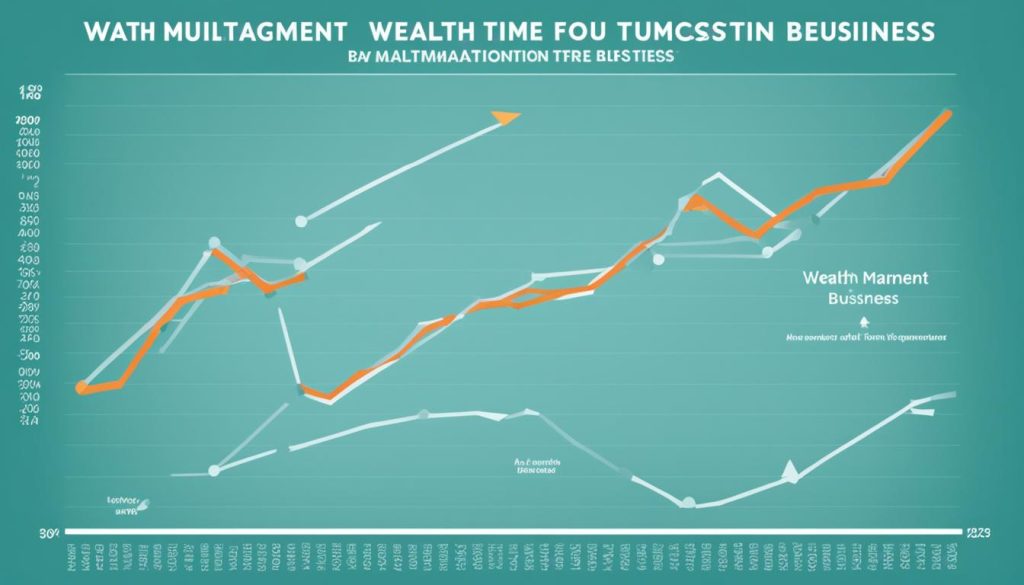Valuation: Measuring and Managing the Value of Companies is a comprehensive book that provides complete guidance on every aspect of corporate valuation. Whether you are a financial professional looking to enhance your valuation skills or an investor seeking to determine the value of a wealth management firm, this book is a valuable resource.
With insights into both core and advanced valuation strategies, including value creation, performance analysis, capital structure, and valuation techniques, Valuation equips you with the knowledge needed to accurately assess the worth of an asset management company.
Real-world valuation examples are also available on the book’s companion website, allowing you to apply the concepts discussed in the book to practical scenarios.
Key Takeaways:
- Valuation: Measuring and Managing the Value of Companies is a comprehensive guide to corporate valuation.
- The book covers both core and advanced valuation strategies.
- Real-world valuation examples are available on the book’s companion website.
- Valuation is crucial in determining the value of a wealth management firm.
- By mastering valuation techniques, you can make informed decisions about asset management companies.
The Importance of Valuation in Wealth Management
Valuation plays a crucial role in the wealth management industry. It allows firms to assess the worth of their business and determine its market value. By accurately assessing the value of a wealth management firm, advisors and investors can make informed decisions about their investments and strategies.
Assessing the Worth of a Wealth Management Firm
One of the primary reasons why valuation is essential in wealth management is to assess the worth of a firm. Valuing a wealth management company involves analyzing various factors, such as the firm’s assets, revenue streams, client base, and reputation. By using comprehensive valuation techniques, firms can gain a better understanding of their market position and competitive advantages.
Pricing Strategies for Wealth Management Businesses
Pricing strategies are crucial in determining the value of a wealth management firm. There are several methods used in valuations, such as multiples or comparables, discounted cash flow, and asset-based valuations.
“Multiples or comparables” is a common valuation method that involves comparing a firm’s value to similar businesses that have been sold in the past. This method provides a benchmark for determining the value of a wealth management firm based on market trends and historical data.
Another pricing strategy is the discounted cash flow (DCF) method, which forecasts a firm’s future cash flows to determine its present value. The DCF approach is widely accepted and provides a comprehensive analysis of a wealth management company’s value.
Asset-based valuations calculate the value of a wealth management firm based on the sum of its parts. This method considers the value of tangible assets such as property, equipment, and intellectual property. It is particularly useful for asset-heavy industries.
Each pricing strategy has its advantages and limitations, and firms often use a combination of methods to arrive at a more accurate valuation.
“Valuation is of paramount importance in the wealth management industry. By accurately assessing a wealth management firm’s worth using various pricing strategies like multiples, discounted cash flow, and asset-based valuations, firms can make informed decisions and strategic investments. Source: Third source”
Valuation is not a one-time event in the wealth management industry. It is an ongoing process that helps firms stay competitive and make informed decisions to drive growth and profitability. By understanding the importance of valuation and utilizing effective pricing strategies, wealth management firms can navigate the dynamic financial landscape with confidence.
Multiples or Comparables in Valuation
When it comes to valuing a wealth management firm, one commonly used method is multiples or comparables. This approach involves looking at what similar businesses have sold for in the past to determine the value of the firm. By comparing key financial metrics and ratios, such as revenue, earnings, or assets, to those of comparable companies in the industry, analysts can estimate the firm’s worth.
The multiples or comparables method is relatively simple and easily accessible, which is why it is widely adopted. By utilizing publicly available financial data and market transactions, analysts can gather the necessary information to conduct their valuation. Furthermore, this method allows for quicker assessments and benchmarking against industry standards.
However, it is important to note that the multiples or comparables method may not be suitable for all industries or sectors, including the wealth management industry. Industries with unique characteristics, such as a lack of comparable public companies or significant differences in business models, might pose challenges in finding relevant comparables.
“The multiples or comparables method is a useful tool in valuation, but it is not without limitations. It is crucial to consider other factors that influence a wealth management firm’s value, such as intangible assets, client relationships, and industry-specific dynamics.”
Additionally, the multiples or comparables method may not take into account all the important factors that influence a firm’s value. It is essential to consider the specific characteristics of the wealth management industry and incorporate additional valuation techniques to ensure a comprehensive assessment.
Risk and Limitations of the Multiples or Comparables Method
While the multiples or comparables method provides a quick and accessible approach to valuation, there are inherent risks and limitations to consider. For instance, relying solely on historical market transactions may not capture the full picture of a firm’s future prospects and potential risks. It is crucial to conduct thorough research and analysis before applying this method and to interpret the results within the context of the specific wealth management firm being valued.
Furthermore, the multiples or comparables method heavily relies on accurate data and relevant comparable companies. Inaccurate or incomplete data can lead to misleading valuations. It is important to ensure the comparables selected are truly similar in terms of business characteristics, size, growth prospects, and risk profiles. Additionally, it is advisable to use a range of multiples to avoid relying too heavily on a single ratio or metric.
Overall, while the multiples or comparables method can provide valuable insights into the valuation of a wealth management firm, it should be used as part of a broader framework that incorporates other valuation methods and considers the unique factors that drive the firm’s value in the wealth management industry.

Discounted Cash Flow (DCF) Valuation
The discounted cash flow (DCF) method is widely recognized as a standard approach to valuations in wealth management firms. This valuation method involves projecting and discounting a business’s future cash flows to determine its present value. By discounting future cash flows, the DCF method takes into account the time value of money, reflecting the concept that a dollar received in the future is worth less than a dollar received today.
DCF valuation provides a comprehensive analysis of a wealth management firm’s value and can cover a wide range of scenarios. It takes into consideration the projected income streams, growth rates, and expected returns on investment. By incorporating these factors, the DCF method provides a holistic view of a firm’s intrinsic value.
However, it is important to note that the accuracy of a DCF valuation heavily relies on the accuracy of input assumptions and forecasts. Inaccuracies in these variables can significantly impact the valuation’s accuracy. Therefore, it is crucial for wealth management professionals to gather and analyze reliable data to ensure the validity of their DCF models. Additionally, the DCF method may not be suitable for industries with unpredictable income or rapid growth, as the assumptions and forecasts required for the calculation can be challenging to accurately predict in such cases.
Overall, the discounted cash flow (DCF) valuation method offers a comprehensive and detailed analysis of a wealth management firm’s value. When applied diligently and based on accurate assumptions and forecasts, DCF helps facilitate informed decision-making and strategic planning for wealth management businesses.

The Role of DCF in Wealth Management
The DCF valuation is particularly useful in wealth management as it helps financial advisors and investors assess the intrinsic value of a firm. By analyzing the projected future cash flows and discounting them to their present value, DCF enables the identification of potential investment opportunities or areas for improvement within a firm’s operations. This valuation method aids in strategic decision-making, such as selecting investment options or assessing the financial viability of mergers and acquisitions. Ultimately, DCF serves as a valuable tool in evaluating the worth of wealth management firms and informing key financial decisions.
Asset-Based Valuation in Wealth Management
When determining the value of a wealth management company, one effective appraisal technique is asset-based valuation. This approach takes a bottom-up perspective, calculating the firm’s value based on the sum of its individual components.
Asset-based valuation considers various assets that contribute to the company’s value. These assets include plant and machinery, intellectual property, and goodwill, among others. By taking into account the tangible and intangible assets owned by the firm, this method provides a comprehensive picture of its overall worth.
This valuation technique is particularly advantageous for asset-heavy industries such as construction or vehicle rentals, where the value of physical assets plays a significant role in determining the company’s value.
However, it’s important to note that asset-based valuation can be complex, especially when dealing with multiple assets at different stages of their life cycle. Calculating the value of each asset accurately requires careful consideration and expertise.

Benefits of Asset-Based Valuation:
- Provides a comprehensive assessment of a wealth management firm’s value.
- Considers both tangible and intangible assets, capturing the full spectrum of value drivers.
- Applicable to asset-heavy industries where physical assets significantly contribute to the company’s worth.
Considerations for Asset-Based Valuation:
- Requires expertise and attention to detail in accurately valuing each asset.
- Complexity increases when dealing with multiple assets at different points in their life cycle.
- May not fully capture the value of intangible assets, such as client relationships and reputation.
By utilizing asset-based valuation techniques, wealth management firms can gain a comprehensive understanding of their worth, accounting for both tangible and intangible assets. This valuation method complements other appraisal techniques, providing a holistic assessment of the company’s overall value.
Common Challenges in Valuing Wealth Management Firms
Valuing wealth management firms can present challenges due to the unique nature of the industry. Factors such as intangible assets, client relationships, and reputation play a significant role in the firm’s value but may be difficult to quantify. Additionally, market conditions, regulatory changes, and industry trends can impact the valuation process. It is essential for wealth management firms to consider these challenges and use appropriate valuation techniques to accurately determine their worth.
One of the key challenges in valuing wealth management firms is the presence of intangible assets. These assets, such as brand value and intellectual property, contribute significantly to the firm’s overall worth. However, they are not easily measurable and require careful analysis and judgment. Valuers need to consider the reputation of the firm and its ability to attract and retain clients, as these factors can greatly influence the firm’s value.
Another challenge is the dynamic nature of the market. Market conditions can greatly impact the valuation of wealth management firms. For example, during periods of economic downturn, the value of a firm may decrease due to a decrease in asset values or a decline in client assets under management. Additionally, regulatory changes can alter the operating landscape for wealth management firms, affecting their business models and earning potential. Valuers need to stay informed about market trends and regulatory developments to accurately assess a firm’s value.
When it comes to valuing wealth management firms, standard appraisal techniques may not fully capture the unique aspects of the industry. Traditional valuation methods such as discounted cash flow analysis or comparables may not adequately account for the specific characteristics of wealth management firms.
As the industry is driven by client relationships, trust, and personalization, a broader perspective is needed
. Valuers need to consider factors such as client retention rates, growth prospects, and the competitive landscape to arrive at a more accurate valuation.
In conclusion, valuing wealth management firms requires a deep understanding of the challenges specific to the industry. Intangible assets, market conditions, and regulatory changes all play a critical role in determining a firm’s worth. By employing appropriate valuation techniques and considering the unique aspects of the industry, wealth management firms can arrive at a more accurate assessment of their value.

Essential Strategies for Valuing Wealth Management Firms
When determining the value of a wealth management company, employing a range of appraisal techniques and strategies is essential to account for the industry’s unique characteristics. Valuing these firms goes beyond simply examining financial statements; other key factors must be considered to arrive at a comprehensive and accurate valuation.
One crucial aspect to evaluate is the firm’s client retention rate. This metric provides insight into the loyalty and satisfaction of the client base, which directly influences the company’s long-term profitability. A higher client retention rate signifies a stable and successful wealth management firm, positively impacting its value.
Another critical factor to assess is the growth of assets under management (AUM). Monitoring AUM growth over time allows valuation practitioners to gauge the firm’s ability to attract and retain clients, as well as its success in generating new business. A consistent increase in AUM indicates a thriving wealth management company, contributing to its overall value.
Revenue streams are also significant in valuing wealth management firms. These can include management fees, performance fees, and other sources of income. Understanding the stability and predictability of a firm’s revenue is crucial to accurately assessing its value. A diversified revenue stream, with multiple sources of income, provides a more robust financial foundation and enhances the firm’s value.
Additionally, it is essential to consider the competitive landscape when valuing wealth management firms. Analyzing the competitive positioning of a firm within the industry helps identify its unique value proposition and differentiating factors. This analysis includes evaluating the firm’s market share, reputation, and brand recognition. A strong competitive advantage can significantly impact the valuation of a wealth management company.
When appraising wealth management firms, it is crucial to adopt a comprehensive approach that combines both quantitative and qualitative analysis. This method ensures a more accurate and informed valuation, taking into account the firm’s financial performance, client base, growth potential, and competitive advantage.
“Valuing a wealth management firm requires a deep understanding of the industry and a combination of valuation methods.”
By employing essential strategies for valuing wealth management firms, advisors and investors can gain valuable insights into the company’s worth. Taking into consideration key factors such as client retention rates, AUM growth, revenue streams, and the competitive landscape allows for a more holistic and precise valuation process. Source: Third source

Conclusion
Assessing the worth of a wealth management firm requires a deep understanding of the industry and a combination of valuation methods. The book Valuation: Measuring and Managing the Value of Companies offers comprehensive guidance on all aspects of corporate valuation, making it an invaluable resource for financial professionals. By utilizing strategies such as multiples or comparables, discounted cash flow, and asset-based valuations, wealth management firms can accurately determine their worth and make informed decisions to drive their businesses forward.
However, it is crucial to acknowledge the specific challenges and characteristics of the wealth management industry when conducting valuations. Factors like intangible assets, client relationships, and reputation can significantly influence a firm’s value but are often difficult to quantify. Adjusting valuation techniques to consider these unique aspects is essential for achieving reliable and accurate results.
Valuing a wealth management firm is an intricate process that requires attention to detail and a comprehensive approach. By leveraging the insights provided by Valuation: Measuring and Managing the Value of Companies and considering the specific challenges of the industry, financial professionals can effectively assess the worth of wealth management firms and navigate the complexities of this dynamic and evolving sector.


No comments! Be the first commenter?